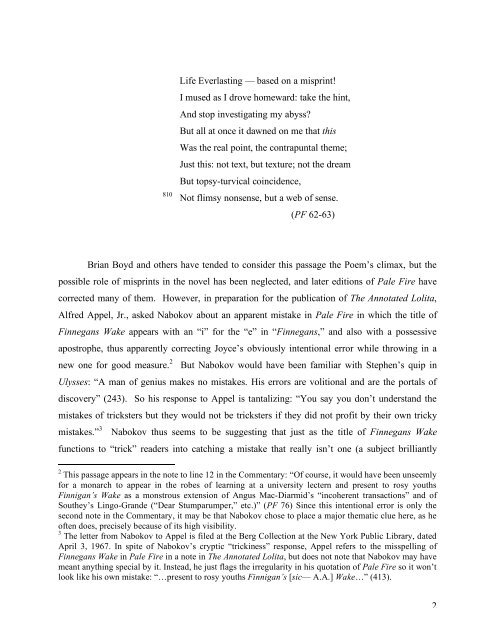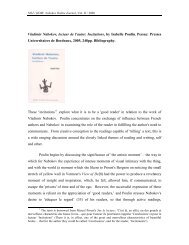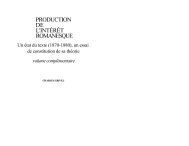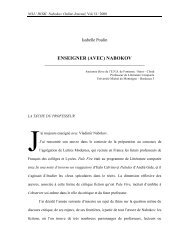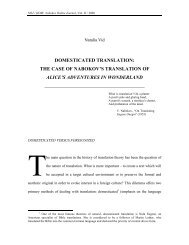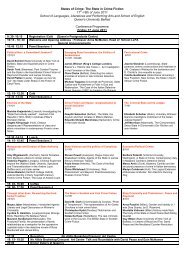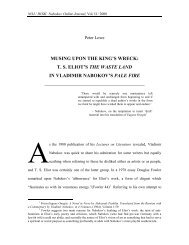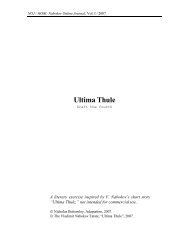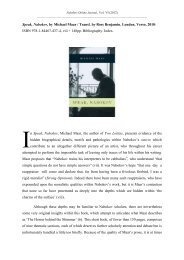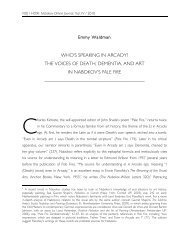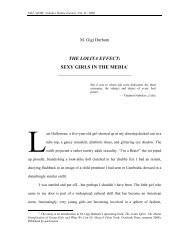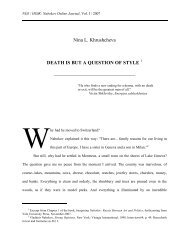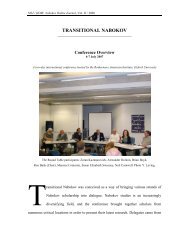Create successful ePaper yourself
Turn your PDF publications into a flip-book with our unique Google optimized e-Paper software.
Life Everlasting — based on a misprint!<br />
I mused as I drove homeward: take the hint,<br />
And stop investigating my abyss?<br />
But all at once it dawned on me that this<br />
Was the real point, the contrapuntal theme;<br />
Just this: not text, but texture; not the dream<br />
But topsy-turvical coincidence,<br />
810 Not flimsy nonsense, but a web of sense.<br />
(PF 62-63)<br />
Brian Boyd and others have tended to consider this passage the Poem’s climax, but the<br />
possible role of misprints in the novel has been neglected, and later editions of <strong>Pale</strong> <strong>Fire</strong> have<br />
corrected many of them. However, in preparation for the publication of The Annotated Lolita,<br />
Alfred Appel, Jr., asked Nabokov about an apparent mistake in <strong>Pale</strong> <strong>Fire</strong> in which the title of<br />
Finnegans Wake appears with an “i” for the “e” in “Finnegans,” and also with a possessive<br />
apostrophe, thus apparently correcting Joyce’s obviously intentional error while throwing in a<br />
new one for good measure. 2 But Nabokov would have been familiar with Stephen’s quip in<br />
Ulysses: “A man of genius makes no mistakes. His errors are volitional and are the portals of<br />
discovery” (243). So his response to Appel is tantalizing: “You say you don’t understand the<br />
mistakes of tricksters but they would not be tricksters if they did not profit by their own tricky<br />
mistakes.” 3 Nabokov thus seems to be suggesting that just as the title of Finnegans Wake<br />
functions to “trick” readers into catching a mistake that really isn’t one (a subject brilliantly<br />
2 This passage appears in the note to line 12 in the Commentary: “Of course, it would have been unseemly<br />
for a monarch to appear in the robes of learning at a university lectern and present to rosy youths<br />
Finnigan’s Wake as a monstrous extension of Angus Mac-Diarmid’s “incoherent transactions” and of<br />
Southey’s Lingo-Grande (“Dear Stumparumper,” etc.)” (PF 76) Since this intentional error is only the<br />
second note in the Commentary, it may be that Nabokov chose to place a major thematic clue here, as he<br />
often does, precisely because of its high visibility.<br />
3 The letter from Nabokov to Appel is filed at the Berg Collection at the New York Public Library, dated<br />
April 3, 1967. In spite of Nabokov’s cryptic “trickiness” response, Appel refers to the misspelling of<br />
Finnegans Wake in <strong>Pale</strong> <strong>Fire</strong> in a note in The Annotated Lolita, but does not note that Nabokov may have<br />
meant anything special by it. Instead, he just flags the irregularity in his quotation of <strong>Pale</strong> <strong>Fire</strong> so it won’t<br />
look like his own mistake: “…present to rosy youths Finnigan’s [sic— A.A.] Wake…” (413).<br />
2


